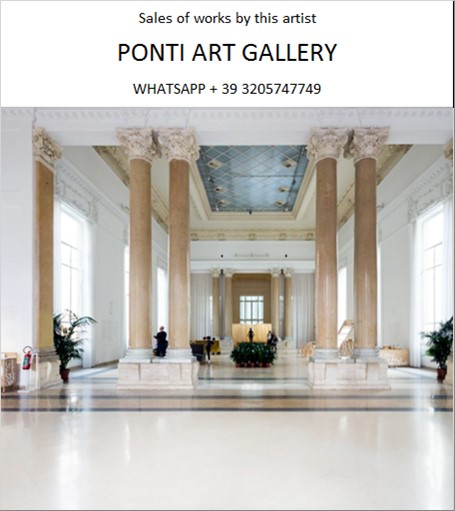Ponti Art Gallery is interested in buying and selling works
of art by this artist.

Alexander Calder Biography
Alexander Calder, an American sculptor and painter, was born on July 22, 1898, in Lawnton, Pennsylvania. He hailed from a family deeply rooted in the arts; his father, Alexander Stirling Calder, was a well-known sculptor, his mother, Nanette Lederer Calder, a professional portrait artist, and his grandfather, Alexander Milne Calder, a sculptor best known for the colossal statue of William Penn atop Philadelphia City Hall's tower. Despite this artistic lineage, Calder initially chose to study mechanical engineering, graduating from the Stevens Institute of Technology in 1919.
Calder's engineering background would later inform his artistic work, particularly his most famous contributions to art: the mobile and the stabile. However, it wasn't until 1923 that he began to pursue art seriously, enrolling at the Art Students League in New York City. His early work included illustrations for the National Police Gazette, which sent him to sketch scenes from the Ringling Bros. and Barnum & Bailey Circus. This experience would profoundly influence his later work, particularly his renowned "Cirque Calder," a miniature circus crafted from wire, leather, cloth, and other found materials.
In 1926, Calder moved to Paris, where he became part of the city's vibrant avant-garde art scene. It was here that he began to develop his unique style of sculpture, creating figures from wire that were effectively three-dimensional drawings in space. His performances of "Cirque Calder" became popular among the Parisian artistic community, and his work began to gain recognition.
Calder's visit to the studio of Piet Mondrian in 1930 was a pivotal moment in his career. Inspired by Mondrian's abstract geometric paintings, Calder began to explore abstraction and kinetic art. He created his first truly kinetic sculptures, which Marcel Duchamp would later name "mobiles," a term that stuck and became synonymous with Calder's work. These mobiles were balanced assemblies of shapes that moved in response to air currents, and they marked a significant development in the field of sculpture, introducing the element of movement into a traditionally static art form.
Throughout the 1930s and 1940s, Calder continued to innovate, creating both mobiles and stabiles (the latter term coined by Jean Arp to describe Calder's monumental static sculptures). His work was characterized by its playful nature, bold colors, and organic forms. Calder's sculptures were not only visually engaging but also engineered to move in complex and subtle ways, reflecting his fascination with the natural world and the underlying principles of physics.
Calder's contributions to art were not limited to sculpture. He also created paintings, prints, jewelry, and even household objects, applying his distinctive aesthetic to a wide range of media. His work in the theater included designing sets and costumes for ballets and plays, further showcasing his versatility as an artist.
In the post-war years, Calder's reputation continued to grow. He received numerous public commissions and his work was exhibited widely. Major retrospectives of his work were held at the Guggenheim Museum in New York in 1964 and at the Fondation Maeght in Saint-Paul-de-Vence, France, in 1969. Calder's work was celebrated for its innovation, whimsy, and the joy it brought to viewers.
Calder passed away on November 11, 1976, in New York City, but his legacy endures. His work is held in major collections worldwide, and his public sculptures continue to be iconic landmarks. The Calder Foundation, established after his death, continues to preserve and promote his work, ensuring that his contributions to modern art are recognized and appreciated by future generations.
Calder's influence on contemporary art is profound. His exploration of movement, balance, and form opened new possibilities for sculpture and established him as one of the most innovative and beloved artists of the 20th century. His work remains a testament to the power of creativity and the enduring appeal of art that engages both the intellect and the senses.
Alexander Calder Quotes and
Sales of Works
Ponti Art Gallery selects and deals with paintings by the
artist. Upon request, we provide free estimates and
evaluations, communicate prices, quotations, and current
market values.
If you are interested in BUYING or SELLING works by the
artist, contact us immediately.
If you wish to sell or receive an evaluation of the
works:
Send us a frontal photo of the painting, one of the back,
and one of the signature. Also, indicate the dimensions of
the work. Inform us about the purchase origin of the work
and any kind of available documentation (purchase
receipts, certificates of authenticity, publications). One
of our operators will respond to you on the same day. We
guarantee maximum confidentiality and extreme
professionalism.
If you wish to purchase works by the painter: Contact us
and let us know your request. We will inform you about the
available works. We also offer the possibility to
subscribe to our NEWSLETTER, through which you will be
informed at the beginning of each month about the latest
acquisitions of the art gallery.
You can send us pictures of the work:
